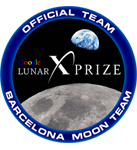High Resolution Images
Barcelona Moon Team: Chang’e3 comparative analysis. News, News (eng)

Last weeks we have seen how Chang’e-3 landed on the Moon surface and released the Yutu rover. Barcelona Moon Team mission will be similar in many aspects, but not in all of them. Here there are some differences between both missions.
First: the launcher vehicle.
Chang’e 3 was launched on 1 December 2013 atop a Long March 3B rocket flying from Launch Complex 2 at the Xichang Satellite Launch Centre in the southwestern province of Sichuan. BMT will also be launching from the Xichang Complex, but the BMT lander module will be atop a 2 liquid stages Long March 2C with an additional solid upper stage CTS-2 for lunar transfer orbit insertion.
Second: the Moon landing.
Chang’e 3 entered a 100 km-high circular lunar orbit on 6 December 2013. Later, the spacecraft adopted a 15 km × 100 km elliptic orbit. The landing took place one week later, on 14 December. At periapsis, its variable thrusters were again fired in order to reduce its velocity, descending to 100 m above the Moon’s surface. It hovered at this altitude, moving horizontally under its own guidance to avoid obstacles, before slowly descending to 4 m above the ground, at which point its engine was shut down for a free-fall onto the lunar surface. The landing sequence took about 12 minutes to complete. Topographic data from the Chang’e 1 and 2 orbiters were used to select a landing site for Chang’e 3. The planned landing site was Sinus Iridum, but the lander actually descended on Mare Imbrium, about 40 km south of the 6 km diameter Laplace F crater, at 44.1214°N, 19.5116°W (2640 m elevation), on 14 December 2013, with a landing mass of 1,200 kg, it also carried and deployed the 140 kg rover.
BMT lunar lander will also insert in a circular 100km circular lunar orbit from where it will perform crater recognition before receiving the break off command. After that the lander will autonomously perform a propelled descent until softly touch down about 15 minutes later.
Third: the rover descent on the Moon.
Yutu, the Chinese rover, descent to lunar surface over tracks deployed by Chang’e-3. It serves double-duty as a technology demonstrator to be further refined for the planned 2018 Chang’e 5 sample-return mission. Unfortunately, Yutu seems to have had some problems during its preparation for the lunar night.
BMT rover will “fall†to the Moon surface from its loaded position on the lander side, but due to Moon minor gravity will slowly touchdown and be ready to start roving to achieve 500 meters and wind the Google Lunar X PRIZE.















